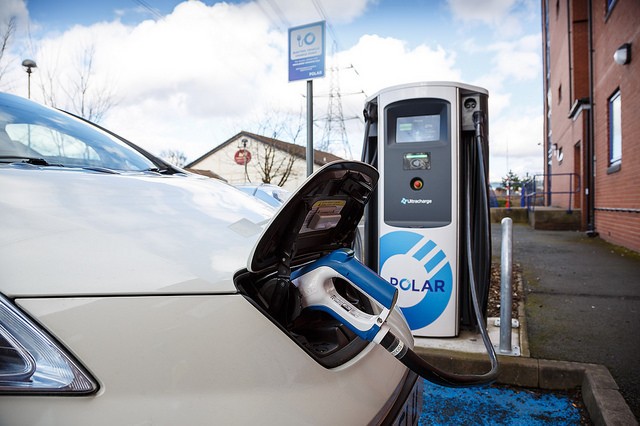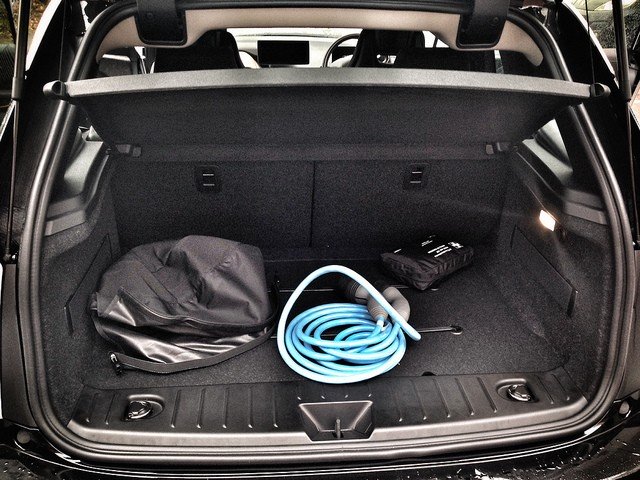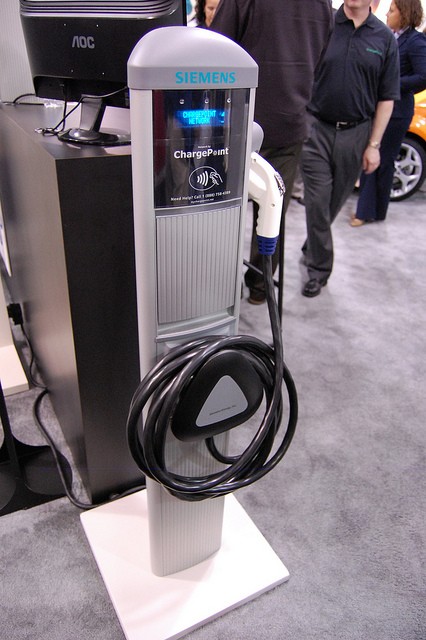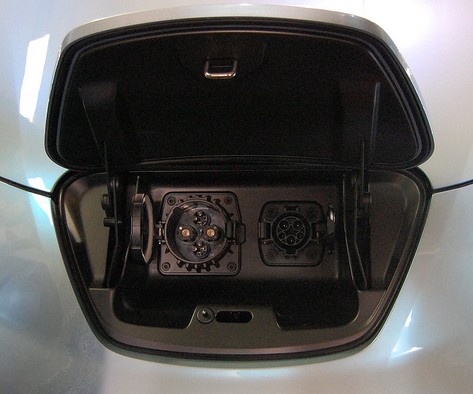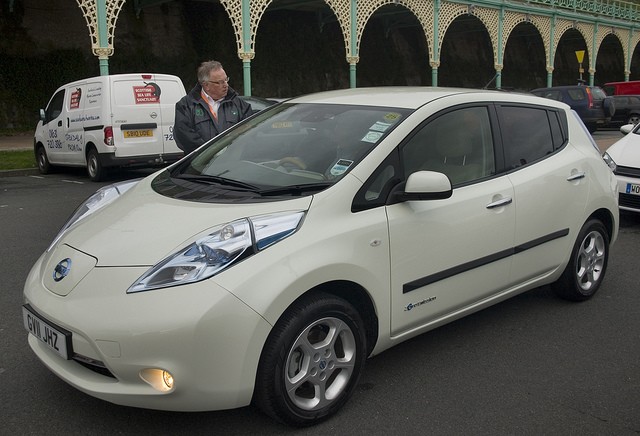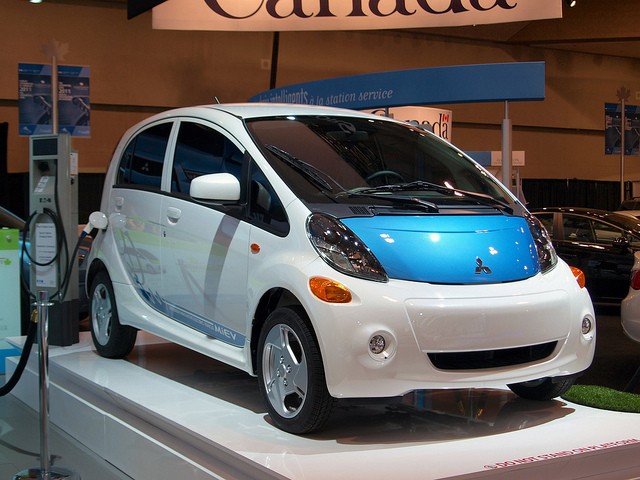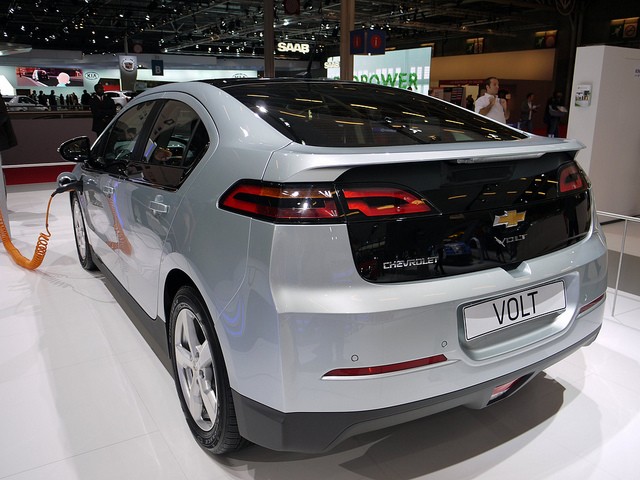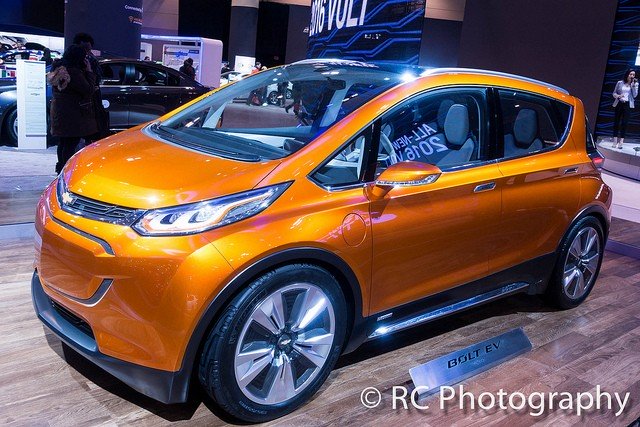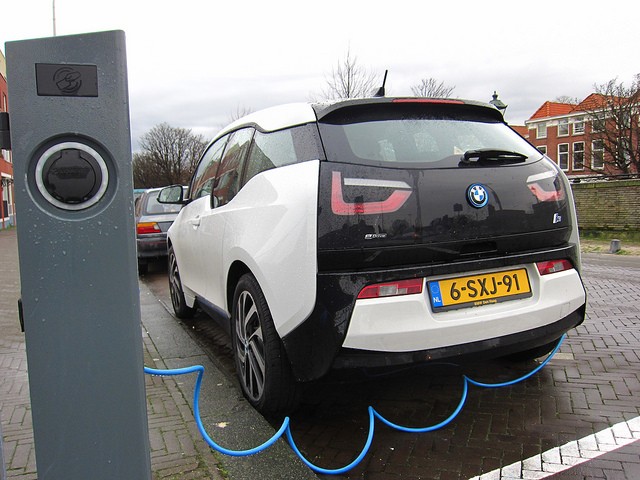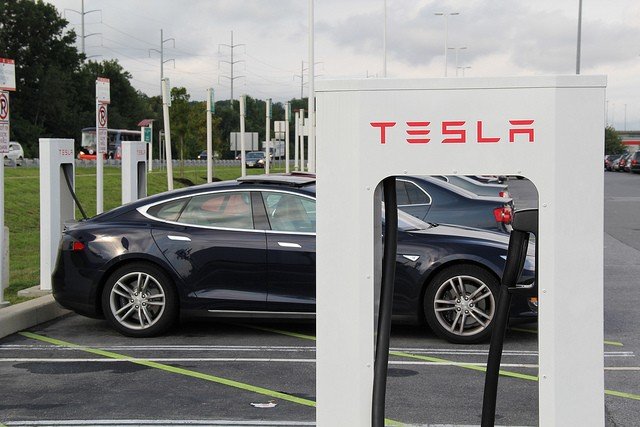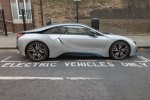Electric Car Charging
So you've got a brand new (to you) electric car. Before the battery runs down...
What are your electric car charging options?
We will discuss the different levels of charging, charging station apps, and how-to tips for charging all kinds of electric cars.
Level 1 charging: Easy as falling off a log
My LEAF, like all electric cars, came with a level 1 electric car charging cord in a bag in the back of the car. That's 120 V, just like the toaster. You can plug this into any grounded outlet. My LEAF's charger pulls 15 amps, so if your wiring is old like mine, you might have to shut off everything else on that circuit while you charge (or reset your breaker when it pops). The car will regain about 5 miles of range per hour of level 1 charging.
I've found this to be the most convenient way to recharge my own car. I just plug it in when I get home, go about my business, and in the morning the car is topped up and ready to go again. If you've got a grounded outlet near where you park, and you don't tend to drive more than about 100 miles – the 24 kwh LEAF's range – in one day, this might be your choice too.
Level 2 charging: Fast! but not quick
Level 2 charging is 240 volts, just like your kitchen range or your dryer. If you've got 240 volt wiring already in place in your garage, you can either plug in a portable Level 2 charger to the existing outlet, or you can have a permanent level 2 charger installed. This cuts your recharge time considerably. My LEAF (2013) has a 6.6 kw charger, so it can recover all its charge from empty to full in about 4 hours.
In real life, you are unlikely to actually do that “0-100% in 4 hours” thing, tapping your foot as you wait impatiently.
That's because gas-guzzler refueling habits are different than electric car refueling habits, and before you actually have an electric car in your driveway it is almost impossible to imagine how something so basic as “filling the tank” - something we've been doing since we were teenagers – can change so much.
The truth is, even when your recharge time is “overnight”, you will spend far less time charging your electric car than you used to at the gas station filling up. You get home, you pop the charging flap, you plug in, and the electron fairies take care of the rest. In the morning, it's done. You unplug and go. Ten seconds? Twenty? No more than that.
This is why electric car people's eyes glaze over when you ask them how long it takes to recharge. The answer is: who cares? I'm making dinner for the family and watching Game of Thrones. The car is doing its thing out there without me.
What about level 2 charging your car away from home?
This is ideal if you have a longish commute and you can plug in at work. There are also level 2 chargers in lots of places where you might spend a little time, such as restaurants and shopping malls.
How fast will it charge? Depends...
- Your car itself has a charging speed limit, or a maximum rate that it can accept charge; and
- Every level 2 charging station has its own speed limit, or maximum rate at which it can deliver charge.
Most often you discover this by plugging in. Some level 2 chargers, you'll soon learn, are faster than others.
Why are some level 2 chargers faster than others, you quite reasonably ask?
Well, because level 2 just refers to the voltage; all level 2 chargers have same voltage but maybe different amps, anywhere from 20 to 100. A 20 amp charger goes slower than the 100 amp one and so you might find that you get back 15 miles in an hour of charging at 20 amps and 25 miles in an hour of charging at 50 amps. Both chargers look identical, as far as I can see. The difference is behind the scenes.
Level 3 charging: Quick as lickety-split
The port on the left is for Level 3 charging, called DC quick charging. If you've got the capability, it's pretty cool. It bypasses your car's charger and just sort of downloads charge directly to the battery. There are three ways to do level 3 in the US: CHAdeMO, CCS/SAE, and Tesla Superchargers.
CHAdeMO is the type of quick charge
port you'll find in your LEAF or other Japanese car (Mitsubishi).
CCS/SAE is the level 3 electric car
charging standard for any General Motors product like the Chevy Bolt,
and all the electric cars from BMW, Daimler, Ford, Jaguar,
Volkswagen, and Hyundai. It's the European standard.
(Kia is planning to confuse everyone by
starting out with CHAdeMO on all the Soul EV model years up to 2019,
then switch over to CCS/SAE in 2020, just to keep us all on our toes.)
Tesla Supercharging is the level 3
electric car charging just for Teslas. There's not a CHAdeMO to Tesla
adapter that I know of, nor a CCS/SAE to Tesla adapter. Tesla
superchargers are just for Teslas.
There are adapters that go the other
way, though. Teslas can plug in at any level 2 or level 3 charger
with the appropriate adapter.
Tesla aside, what earthly difference
could it possibly make whether my car has CHAdeMO or CCS/SAE, Lynne?
Well, here's the thing: these Level 3
charging standards are not interchangeable. If your car uses CSS, you
can't just roll up to a CHAdeMO charging station and plug in. Same
with vice versa. (There is apparently an adapter you can purchase
for this, but it doesn't come with your car.)
So I'm kind of envisioning myself going
to a dealership, seeing the quick charge port, plunking my
pennies down on the spot, grabbing keys and yelling WAHOO, ROAD
TRIP!!
…taking off for parts unknown, hair
flying in the wind...
...and then discovering when I get to
parts unknown that the quick charger I was planning to plug into is
not the right sort. And there's not the right sort for a
hundred miles.
I don't want this to happen to you. Trying to keep the JOY in “joyride” here, my friends.
Which charger goes to what electric car?
Nissan LEAF
- (100-150 miles of electric range; varies depending on battery size/model year)
- Slow Charging (Level 1, 120 V) Overnight
- Fast Charging (Level 2, 240 V, J1772 plug) 2-4 hours
- DC Quick Charging (Level 3, 440 V, CHAdeMO) 30 minutes
Mitsubishi iMiEV
- (62 miles electric range)
- Slow Charging (Level 1, 120 V) 22 hours
- Fast Charging (Level 2, 240 V, J1772 plug) 6 hours
- DC Quick Charging (Level 3, 440 V,
CHAdeMO) 30 minutes to 80%
Chevy Volt
- (50 miles electric range)
- Slow Charging (Level 1, 120 V) 12 hours
- Fast Charging (Level 2, 240 V) 4 hours
- Does not have DC Quick Charging
Note: A Chevy Volt recharges at about half the rate of a battery (100%) electric car.
Chevy Bolt
- (238 miles electric range)
- Slow Charging (Level 1, 120 V) 4 miles per hour (forever)
- Fast Charging (Level 2, 240 V) 25 miles per hour (overnight)
- DC Quick Charging (Level 3, 440 V, CCS/SAE) 90 miles per half hour
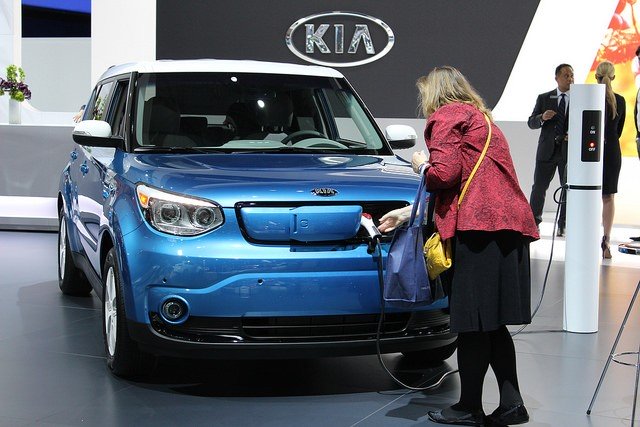 Photo by California Air Resources Board
Photo by California Air Resources BoardKia Soul EV
- (111 miles electric range)
- Slow Charging (Level 1, 120 V) 33 hours
- Fast Charging (Level 2, 220 V) 5 hours
- DC Quick Charging (Level 3, 440 V, CHAdeMO) 100% charged in 23 minutes
BMW i3
- (81-114 miles electric range)
- Slow Charging (Level 1, 120 V) 12-15 hours
- Fast Charging (Level 2, 240 V) 4-6 hours
- DC Quick Charging (Level 3, 440 V, CCS/SAE) 80% charge in 20-30 minutes
Tesla
- (215-315 miles electric range)
- Slow Charging (Level 1, 120 V) 4 days
- Fast Charging (Level 2, 240 V) 6-30 hours
- Supercharging (Level 3, 480 V) 30 minutes to 170 miles
Note: The '08 Tesla Roadster can't use the Supercharger network.
Public EV Charging: How-to, tips, pros/cons, reality
Stuff to know before your first electric car charge
- Not all electric cars have level 3 charging capability. Especially older ones.
- This feature can't be added on later. It must be wired differently from the factory.
- Your dealer might not know a thing about it. Open the charge port and if the quick charge port is sealed, the car doesn't have it.
- Some electric cars have two different speeds of level 2 charging. My LEAF, for example, has 3.3 kw and 6.6 kw settings. This comes in handy if you are charging at home (or at a friend's house) and the wiring is crotchety because it was installed in 1935; in this case you might prefer to use the 3.3 kw rate and, you know, not burn anything down.
- You will need a membership or subscription card to charge. (Or you can just call the number on the charging station, give them your credit card number, and they will turn on the juice for you)
- Each electric car charging station company has its own membership card. You have to call and order one, or sometimes the dealership will give you a charging card that allows you to charge for free for a period of time in certain metro areas.
Lifestyle considerations
- Plug in whenever you can.
- When fully charged, unplug; or else you will run down your 12v accessory battery and not be able to start the car. (Guess how I learned this.)
- Before you buy an electric car, if you already know you'll HAVE to charge at a public charger, you'll want the quick charging option. Why? Because it takes a while to charge and these chargers are often in use, and you can wait a long time for one to just become available. With a quick charge, the longest you'll wait to plug in is 30 minutes, even if you show up right as somebody else is plugging in.
How to find a charging station
Your car's navigation. There is usually an easily accessible charging station database you can access on the road. I never use it. Well, that's not true, I do use the navigation; I just never use the charging station information. They promise that they update it every so often, but...I don't know. Your mileage may vary.
Charging station apps. I think
all the companies that make public charging stations have made apps:
Chargepoint, Blink, Webasto, etc.
Now, I don't want to hurt their
feelings after they went to so much trouble (so don't tell) but I
don't really like any of them.
Plugshare app. Plugshare is free and available for both android and iPhone. This is the one I like and what I have always used. It's got lots of nifty features:
- You can see ALL the charging stations nearby. If people have volunteered their home chargers as an emergency refueling stop, they can be found on there, too.
- You can filter the charging stations that are displayed in your area based on type of charging station (J1772, CHAdeMO or CCS/SAE, Tesla Supercharger).
- You can look at different areas and see what types of chargers are available.
- You can plan a trip and see in advance where you'll need to stop for charging, and
- You can see not just where the chargers are located but whether they're presently in use, whether they are working at all, and get reports from fellow EV drivers on what they found when they charged there. If the charging station is not reliable, they will tell you. You, in turn, can check in with Plugshare and let the other app users know you're there.
Let other EV drivers know you're there?
Why would you want to do that?
Well, let's say you're looking at a
charger hopefully on the app and it says, “in use”. You can then
click on the charger icon and see that it's your friend Jojo's LEAF.
Jojo never minds if you unplug her car in an emergency, as long as
you remember to send along some of Grandma's blackberry jam every
year! No problem. Or, maybe Jojo is sitting in the nearby pub and you
can buy her a pint and catch up.
You will get to know the
other EV drivers in your region from National Drive Electric Week and
other events, and public charging stations can act like a water
cooler for us like-minded folks. Who knows, you might meet the love
of your life at an electric car charging station!
